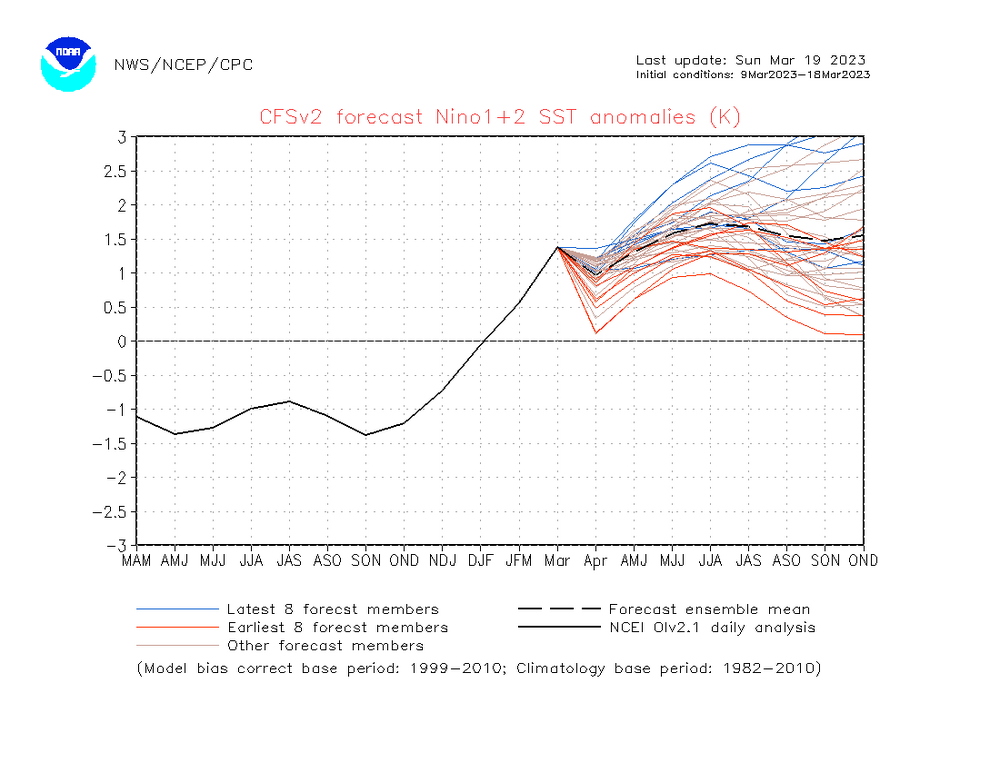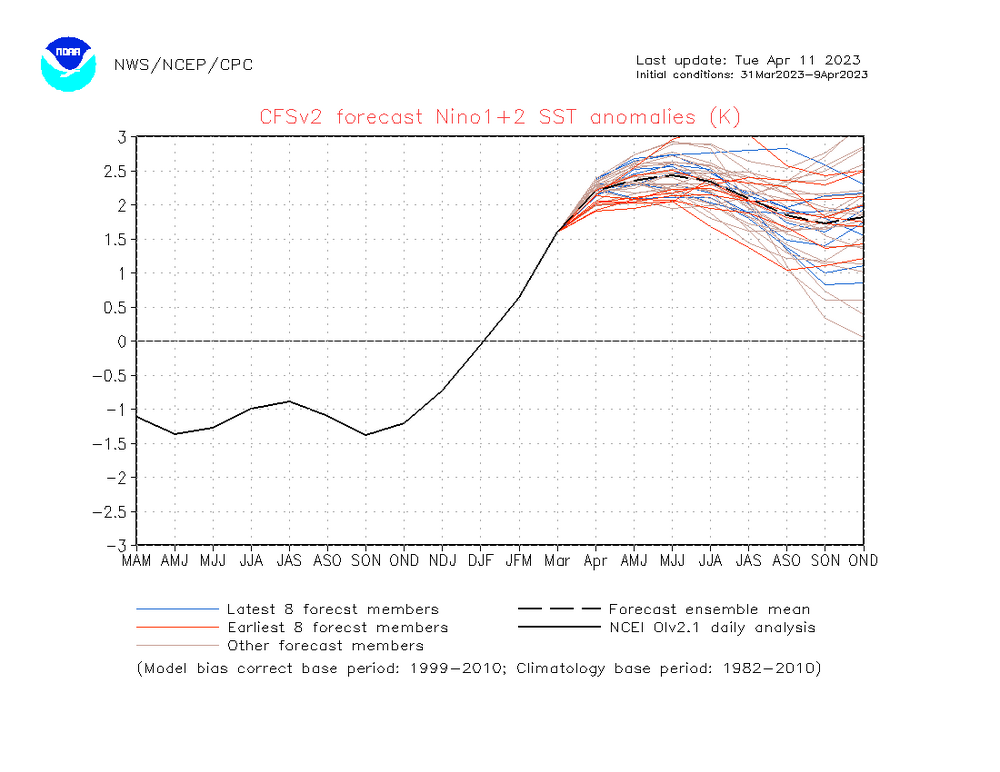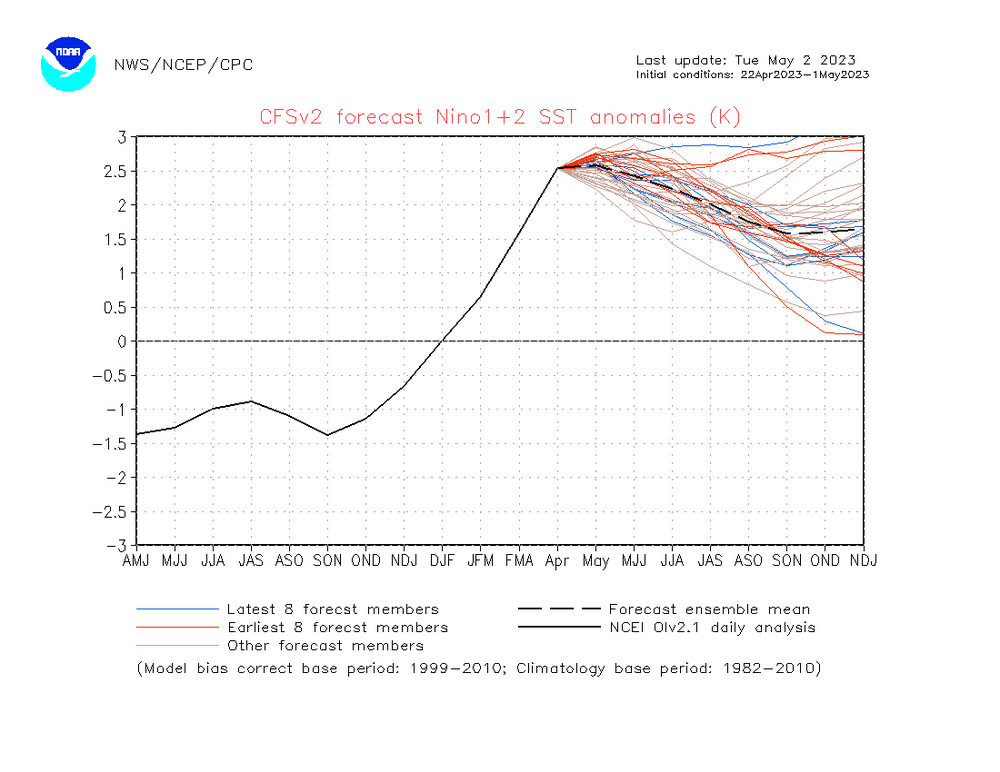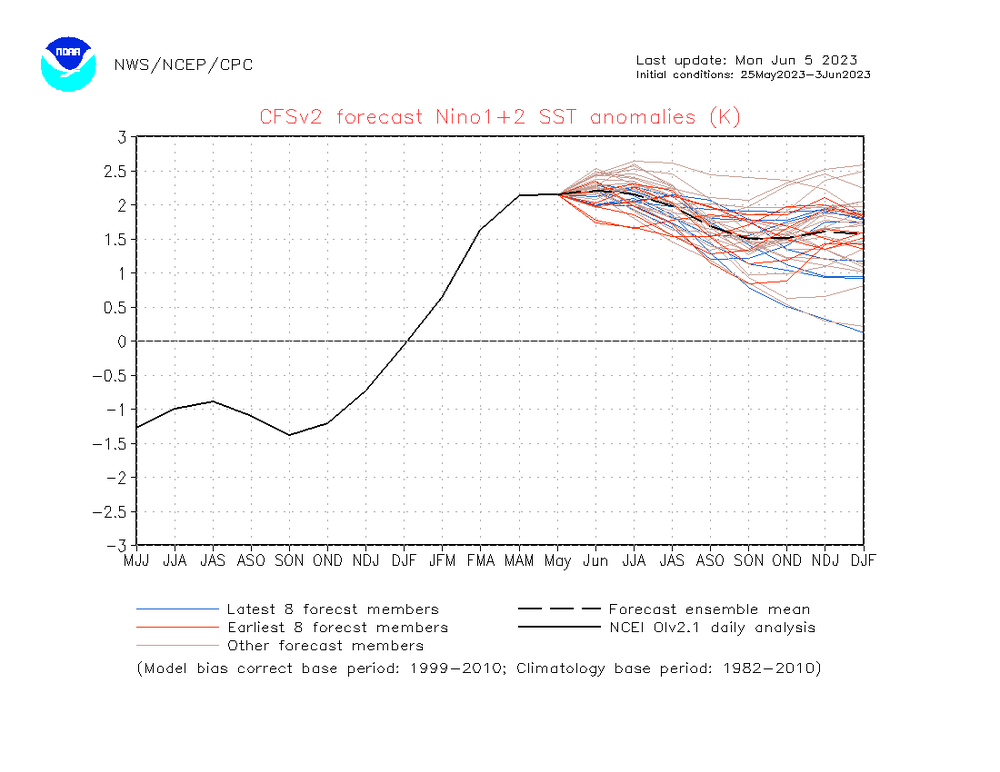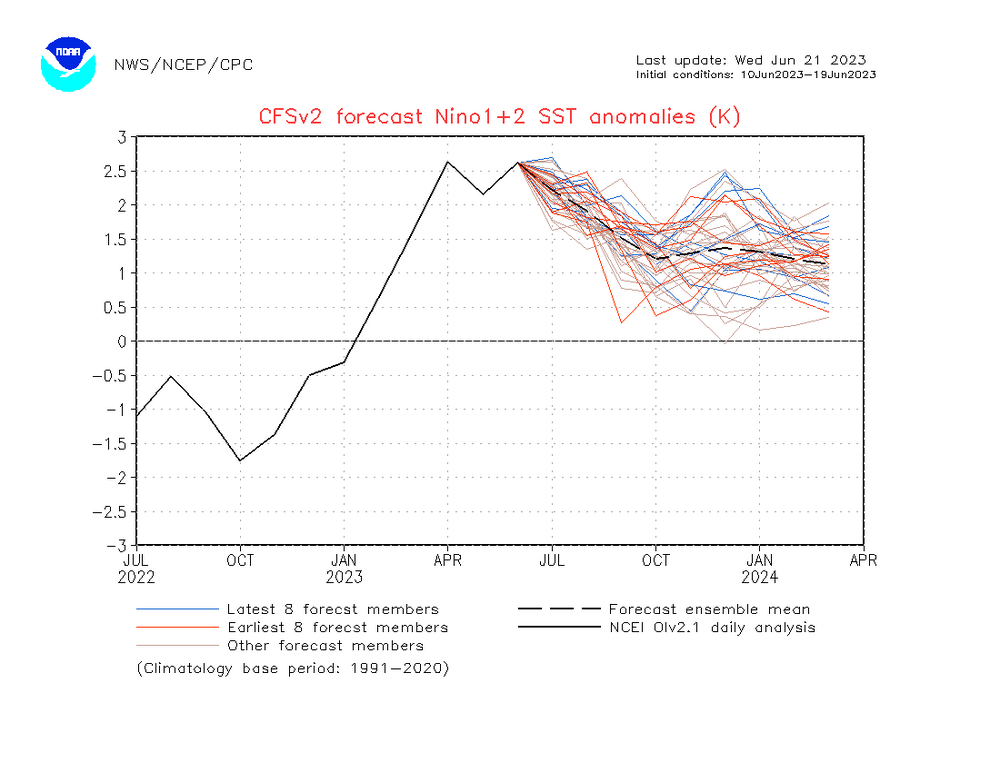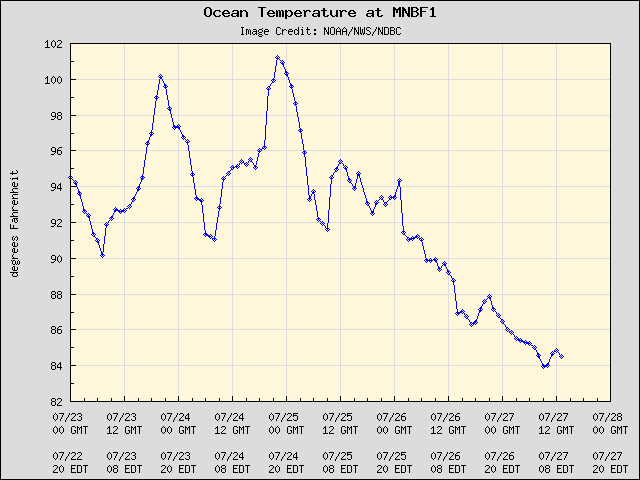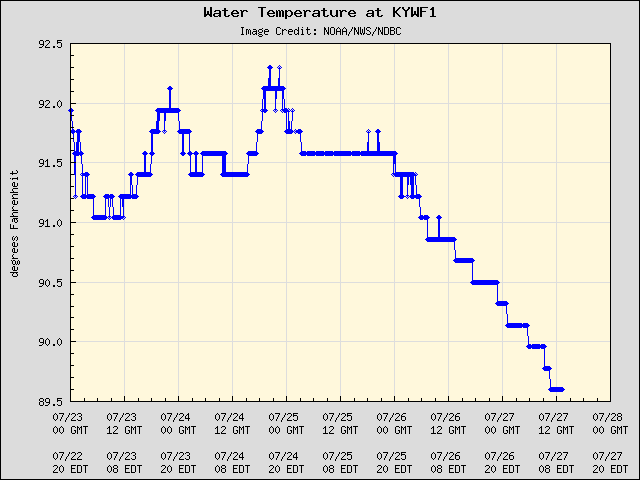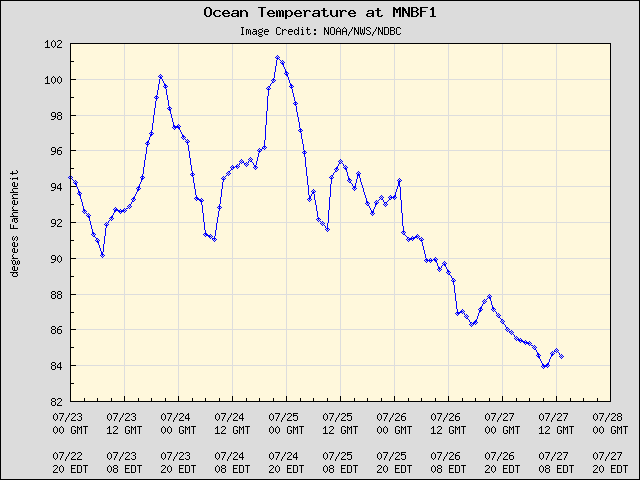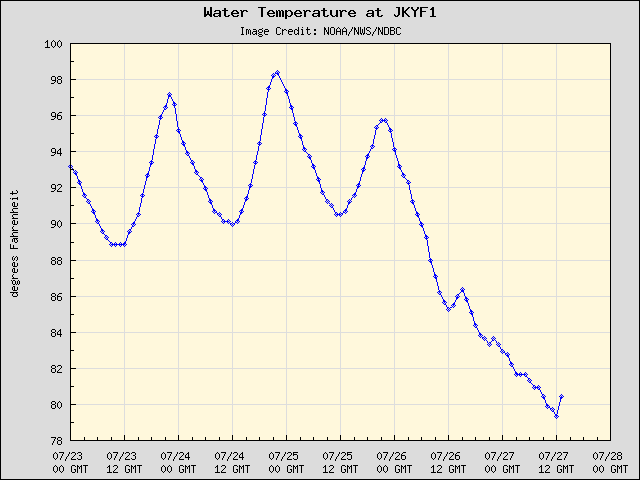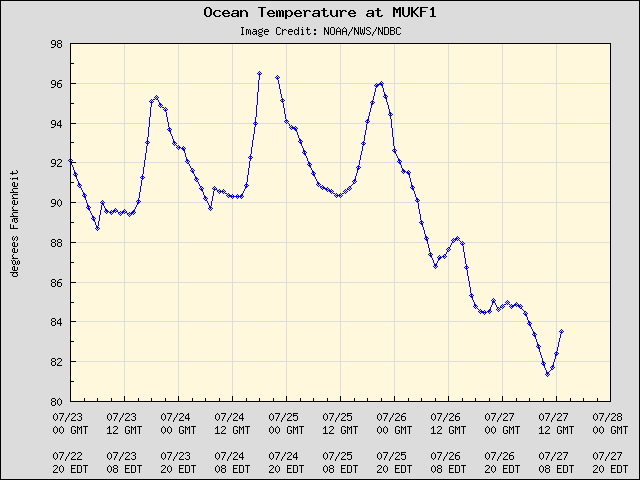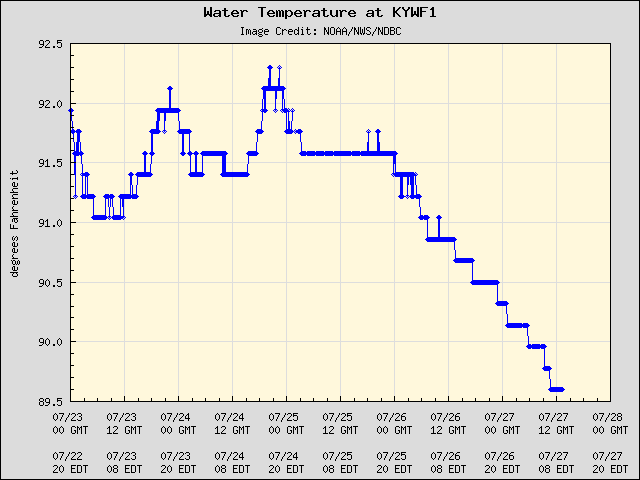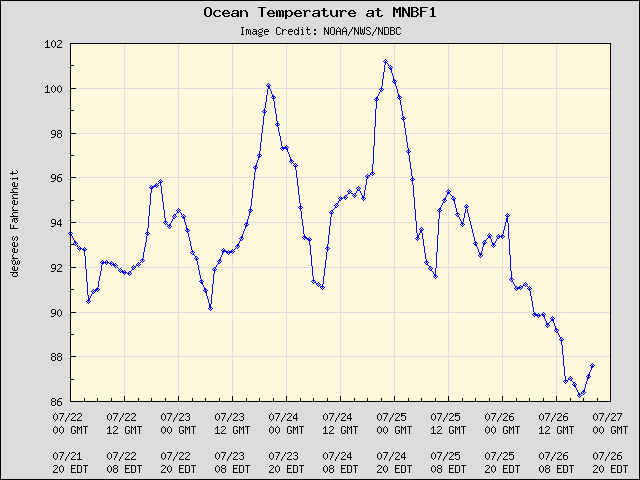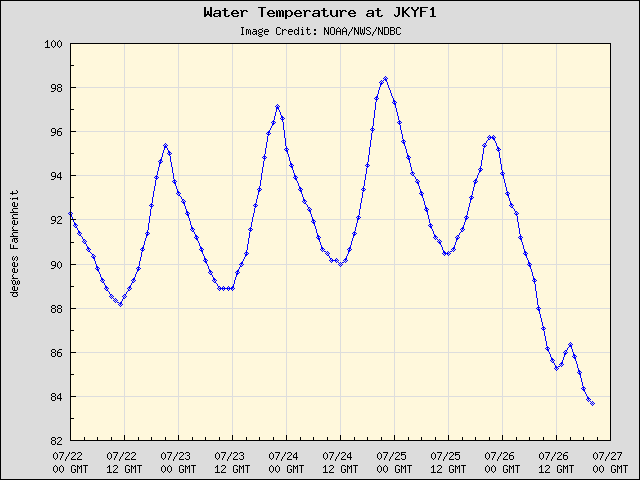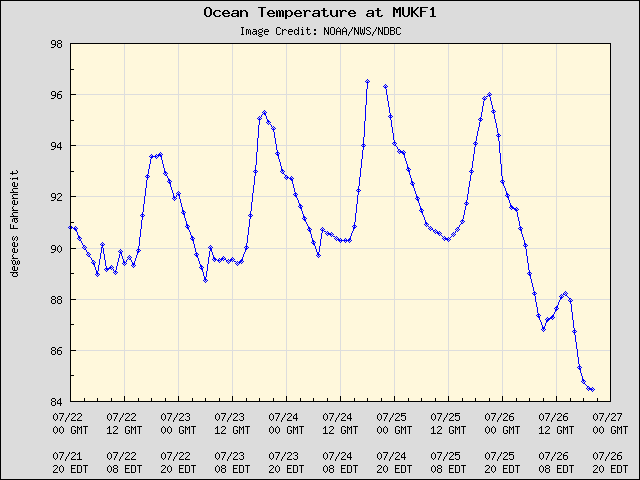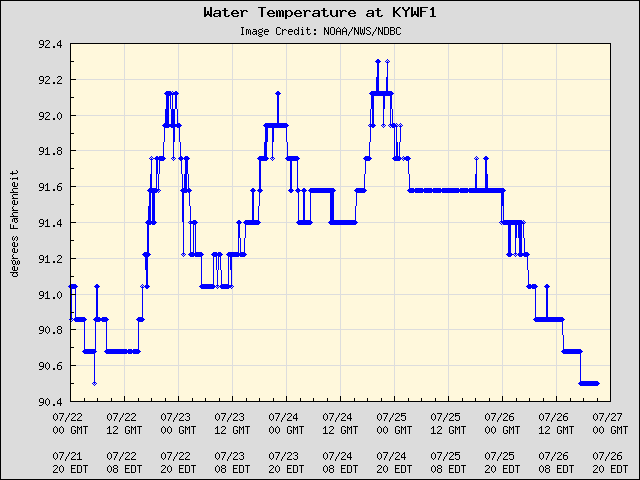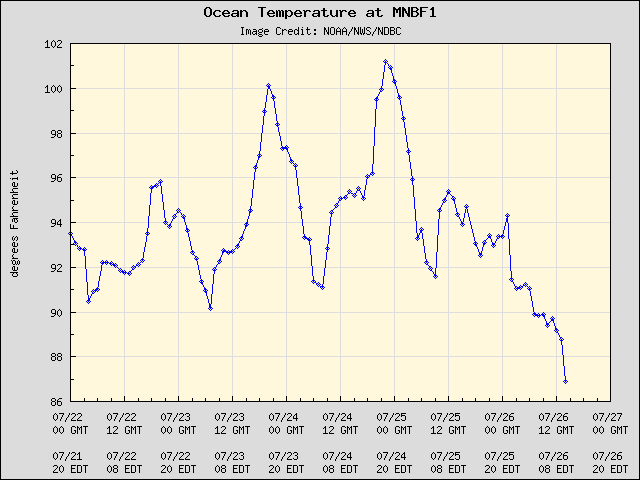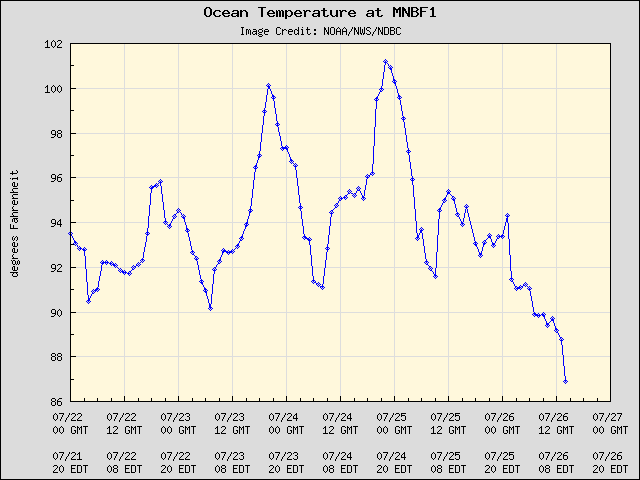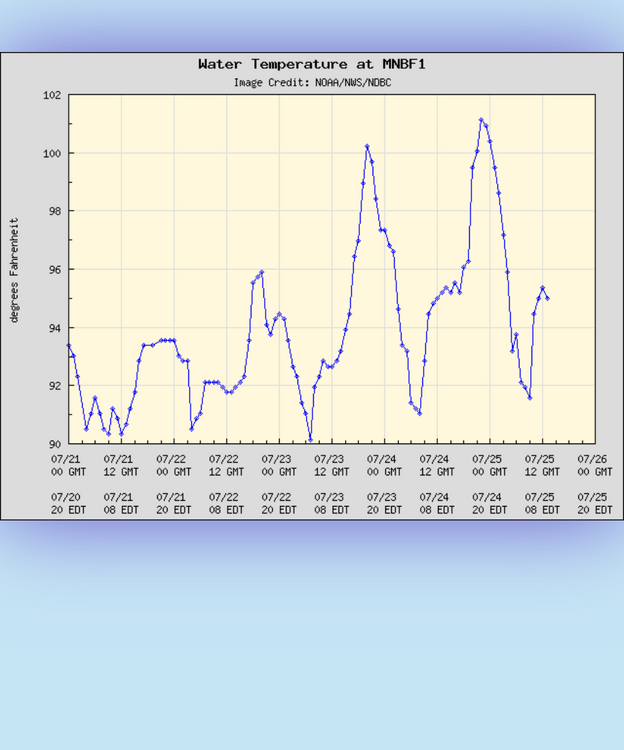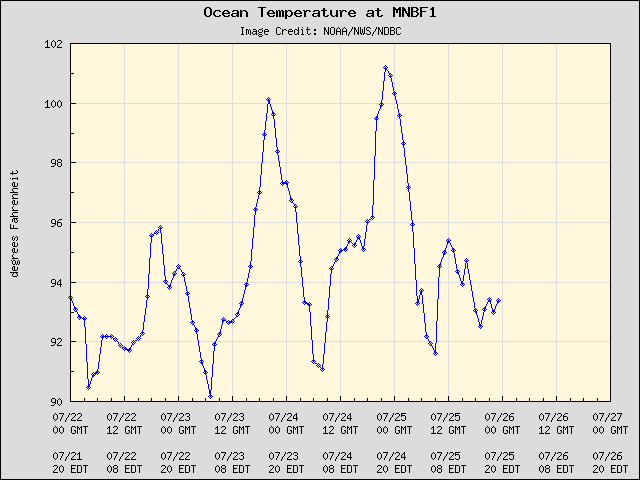
GaWx
Members-
Posts
17,051 -
Joined
Content Type
Profiles
Blogs
Forums
American Weather
Media Demo
Store
Gallery
Everything posted by GaWx
-
Before the new forecasts come out, I'd like to look at the latest 3.4 SST anomaly forecasts issued through 7/30 for August to see how they end up doing: BoM: +1.9 Meteo-France: +1.9 Euro: +1.5 CANSIPS: +1.5 UKMET: +1.4 CFS: +1.3 JMA: +1.3 Any predictions for which of these seven will end up closest to the August ERSST? June was +0.81 and July is likely going to end up +1.0 to +1.1. Current ERSST is probably near +1.1 although daily and weekly ERSSTs technically aren't released.
-
There's a very slight chance (~10%?) that 96L and 97L will both become TDs by tomorrow evening and also subsequently get named. If so, July 2023 would tie July 1997 at three for the most named storms on record with TCG in July in El Niño going back to the last 50+ El Niño seasons. And arguably, the 12Z Euro at least gets close to the two TDs by tomorrow evening.
-
I'd argue based on what I've read from pro mets that the West Pacific/Maritime Continent (MC) has been the dominant region regarding "forcing" for the last five years. These same mets have said that the dominance of the SE ridge in winter has been largely because of this. This MC warmth has lead to a larger than normal % of the time for the MJO to be in the MC phases 4 and 5, a higher than average amplitude in those phases, and MC MJOlike forcing often occurring even when the official MJO wasn't actually in 4 or 5. So, if what you're suggesting were to actually verify and persist through the upcoming winter, I'd look for it to lead to a colder winter in much of the E US in 2023-4 vs recent winters and possibly significantly colder.
-
There have been at a minimum these two broken clocks modelwise: 1. BoA in 3.4 has been way too warm this summer, especially in July when it had many runs of upper +1s as I posted about. 2. CFS has been equally bad with 1+2 considering these way too cool predictions for it since at least March 19th: Mar 19: stays below +1.75 Apr 11: stays below +2.5 May 2: stays below +2.6 June 5: stays below +2.25 June 21: stays below +2.7 Fool me many times, shame on me as regards BoA 3.4. That's been emphasized many times. But fool me many times shame on me regarding the CFS 1+2, too. So, although even much better models such as the Euro all agree that 1+2 either has already maxed or will by Sept at the latest, none have the cliff-dive of the recent CFS, which drops it to a mere +1.2 in November. The Euro, Meteo-France, JMA, and UK all keep Nov from +1.75 to +2.8. Thus, I'd say that the CFS' idea of a cliff-dive in 1+2 is likely way overdone. I think ~+2+ is more realistic. Aside: Also, keep in mind that the CFS was the worst in predicting a moderate MJO phase 5 for now on many runs until 10 days ago.
-
It is now looking likely that July of 2023 will join 1997 to make history for an already moderate El Niño. Currently, the only El Nino with a +1.0+ JJA ONI having 2+ July storms (based on time of TCG) on record is 1997, which had three. The 0Z Euro was the strongest run yet with the mid-MDR disturbance and now the 6Z Euro is even stronger as of the end of its run at hour 90. That could easily result in a TD by July 31st that subsequently gives us Emily. If that's not enough, there's a slight chance that when the disturbance now just offshore NE FL recurves back offshore the E coast that it becomes a TC (as @jconsordiscussed) before July is finished though that could be after 7/31 should it occur.
-
I just put this in the main tropical wx thread (this will lead to plentiful rainfall over a portion of the SE US): There is a tight little circulation center (easily seen on radar) just offshore from Amelia Island where SSTs are ~85F moving NNW toward the lower GA coast, but it is more mid level than low level from what I've read. One NWS discussion mentioned that this is in association with the TUTT (see below). Surface pressures are still pretty high (1017 mb+) and surface winds are light. The highest wind I could find in gusts is 16 knots and that is at an offshore buoy. From Jacksonville NWS office earlier this morning: AT THE SURFACE, AN INVERTED TROUGH ACROSS NORTH CENTRAL FL WILL LIFT NORTH-NORTHWESTWARD UP THE NE FL COAST AND INTO THE ALTAMAHA RIVER BASIN BY THIS EVENING. MEANWHILE, A TROPICAL UPPER TROPOSPHERIC TROUGH (TUTT) AND ASSOCIATED VORTICITY MAX WILL ROTATE ACROSS THE AREA. -------------- From Melbourne ~40 minutes ago: ISSUED AT 924 AM EDT FRI JUL 28 2023 IN THE WAKE OF THE DISTURBANCE THAT MOVED OVERHEAD YESTERDAY, DEEP S/SE FLOW IS IN PLACE ACROSS MUCH OF THE FL PENINSULA THIS MORNING. IN FACT, THAT FEATURE HAS ACTUALLY CLOSED OFF INTO A WEAK SURFACE LOW NEAR JACKSONVILLE.
-
There is a tight little circulation center (easily seen on radar) just offshore from Amelia Island where SSTs are ~85F moving NNW toward the lower GA coast, but it is more mid level than low level from what I've read. One NWS discussion mentioned that this is in association with the TUTT (see below). Surface pressures are still pretty high (1017 mb+) and surface winds are light. The highest wind I could find in gusts is 16 knots and that is at an offshore buoy. From Jacksonville NWS office earlier this morning: AT THE SURFACE, AN INVERTED TROUGH ACROSS NORTH CENTRAL FL WILL LIFT NORTH-NORTHWESTWARD UP THE NE FL COAST AND INTO THE ALTAMAHA RIVER BASIN BY THIS EVENING. MEANWHILE, A TROPICAL UPPER TROPOSPHERIC TROUGH (TUTT) AND ASSOCIATED VORTICITY MAX WILL ROTATE ACROSS THE AREA. -------------- From Melbourne ~40 minutes ago: ISSUED AT 924 AM EDT FRI JUL 28 2023 IN THE WAKE OF THE DISTURBANCE THAT MOVED OVERHEAD YESTERDAY, DEEP S/SE FLOW IS IN PLACE ACROSS MUCH OF THE FL PENINSULA THIS MORNING. IN FACT, THAT FEATURE HAS ACTUALLY CLOSED OFF INTO A WEAK SURFACE LOW NEAR JACKSONVILLE.
-
SST anomalies compared to July 1st in Nino 3.4: -OISST is 0.249C warmer -CRW is 0.192C warmer -CDAS is 0.134C warmer These are quite underwhelming to me when considering the strong acceleration of warming forecasted by the BoM model for July. Based on OISST, it appears July as a whole will end up near 1.1. The implication of a 1.1 July OISST would be a July ERSST (input for ONI calculation) to be most likely in the 1.0 to 1.1 range. Compare these numbers to the prior BoM runs July predictions: Run/July prediction: 2/11/23: 1.3 2/25/23: 1.4 3/11/23: 1.7 3/25/23: 1.9 4/8/23: 1.4 4/22/23: 1.8 5/6/23: 1.8 5/20/23: 1.7 6/3/23: 1.7 6/17/23: 1.8 7/1/23: 1.5 http://www.bom.gov.au/climate/ocean/outlooks/index.shtml#region=NINO34
-
Indeed. More on the Marathon Bay buoy's 101.1F from the link below: The record for the Manatee Bay site is 102 degrees. It was set on Aug. 15, 2017. Going further back, Zierden said the site recorded a temperature of 100 degrees in 2010. "Keep in mind that the observations in Manatee Bay are in shallow water in a closed-off cove with dark seagrass on the bottom," Zierden said. "I would not consider them a "sea surface temperature," as that implies open ocean." https://www.news-press.com/story/weather/2023/07/26/record-water-temperatures-in-florida-not-unprecedented-manatee-bay-climate-center-keys-everglades/70468485007/
-
Based purely on objective statistics back to the late 1800s for the year following +1.5+ ONI peak El Niños, it is a near coin flip as to whether La Niña will immediately follow. Out of 18, 8 had that occur. However, 6 of the last 7 (since 1972-3) were immediately followed by La Niña. I don't know whether or not a sample size of the most recent 7 cases is large enough to favor La Niña to follow as opposed to keeping it near a coin flip. Note that only 2 of 11 from 1877-8 through 1965-6 were followed by La Niña with 6 in a row from 1918-9 through 1965-6 not. *Corrected
-
Extended summer stormlover74 future snow hole banter thread 23
GaWx replied to BxEngine's topic in New York City Metro
The water hit an amazing 101.1F for a high late Monday afternoon at the Manatee Bay buoy near Miami! This occurred after almost wall to wall sunshine and little rainfall prevailed for July up to that point. However, a weak surface trough subsequently brought the most rainfall and least sunshine in weeks yesterday to those shallow waters resulting in a much cooler SST low of 84.0F this morning: More on Manatee Bay SSTs from the link below: The record for the Manatee Bay site is 102 degrees. It was set on Aug. 15, 2017. Going further back, Zierden said the site recorded a temperature of 100 degrees in 2010. "Keep in mind that the observations in Manatee Bay are in shallow water in a closed-off cove with dark seagrass on the bottom," Zierden said. "I would not consider them a "sea surface temperature," as that implies open ocean." https://www.news-press.com/story/weather/2023/07/26/record-water-temperatures-in-florida-not-unprecedented-manatee-bay-climate-center-keys-everglades/70468485007/ ------------------ OTOH the much more stable SST from the Key West buoy, which is on deeper water, is still near a very warm 90 and is indicative of the overall marine heatwave in the area: -
Report: Another Year of Record Heat for the Oceans
GaWx replied to donsutherland1's topic in Climate Change
Check out how much cooling of the extreme warmth of the SSTs shown by the buoys in/near shallow FL Bay occurred between late Monday afternoon's extreme highs and this morning's lows just from a weak surface trough causing a significant increase in showers (the most rain in weeks) and much less sunshine (these are SSTs (F), not air temperatures): Manatee Bay: from 101 to 84 Johnson Key: from 98 to 79 Murray Key: from 99 to 81 In contrast the Key West buoy, which is in deeper waters and thus has a much lower intraday range that is often only ~1F, cooled much less (from 92.3 to 89.6) and is still very warm: -
Look how much cooling of the extreme warmth of the SSTs shown by the buoys in/near shallow FL Bay occurred between late Monday afternoon's highs and this morning's lows just from a weak surface trough causing a significant increase in showers (the most rain in weeks) and much less sunshine (these are SSTs (F), not air temperatures): Manatee Bay: from 101 to 84 Johnson Key: from 98 to 79 Murray Key: from 99 to 81 In contrast the Key West buoy, which is in deeper waters and thus has a much lower intraday range that is often only ~1F, cooled much less (from 92.3 to 89.6) and is still very warm:
-
Report: Another Year of Record Heat for the Oceans
GaWx replied to donsutherland1's topic in Climate Change
The buoys in shallow water near S FL that had been having daily highest SSTs in the amazing upper 90s to 101.1F and making media headlines recently have all plunged within just two days time. They're only in the 84-88F range as of 4PM today thanks to more rainfall and less sunshine. That's all it took after going several weeks with little rain and mainly clear to partly cloudy skies. This illustrates well why these shallow water buoy SSTs are invalid for world record keeping purposes against, for example, the 99.7 recorded in much deeper waters in the middle of the Kuwait Bay. When you have Dr. Masters agreeing, you can probably take it to the bank that they're invalid. Their variations of ~14-15F occurring just within the last 48 hours show that their SSTs are acting more like coastal land station air temperatures than SSTs: Manatee Bay (range 86-101F): Johnson Key (range 84-98): Murray Key (range 84-99): In stark contrast, the deeper water at the Key West buoy has cooled due to the same rainfall/less sunshine only ~1.5F. That along with daily ranges that have typically been no more than ~2F tells me that the Key West buoy, unlike the other three, likely has valid SSTs for world recordkeeping purposes. The hottest there so far this month has been 92.7F. Although not nearly as hot as those three shallow buoys, it is still quite hot for Key West and indicative of the marine heatwave in the area. The lowest there so far this month has been 88.7. So, the range so far this month at Key West has been only 4.0F. Compare that to the range of ~14-15F just for the last two days at those shallow buoys! Key West (range 90.5-92.3): -
From a strictly SE cold/wintry wx potential perspective, I'd love to see that in winter as the combo of within the circle MJO (especially left side) and El Nino in especially January has made for some of the best opportunities!
-
Troughs near the E coast during hurricane season appear to be more favored during El Niño than non-El Nino seasons. Cape Verde/E MDR storms, which don't hit the US most of the time, hit less often during El Niño vs other seasons per looking at many decades of tracks. But if there are enough of them, one or more may slip in based on averages due to randomness. If they delay development, that ups those chances.
-
The 12Z CMC is by far its strongest run yet with an H to the E of Bermuda. This would make 2 storms with a July TCG, which would make it above average for all seasons. I expect a TWO later today and possibly as early as the one soon to be released to be upgraded from lemon to orange for the 7 day for this. If this month reaches two storms, it would tie it with 1979, 1887, and 1864 for the 2nd highest # of July storms during the 54 El Niño seasons since 1851 either present or coming later that season. Only 1997 would be more active with its three storms that formed in July.
-
^rainstorm trolling 101 has worked well for two decades (this is part of the playbook) but regardless IF it actually develops into a TD, I wouldn't argue against very good chance it would then get to H status with MH quite possible. An impressive 17 of 31 0Z GEFS members, by far the highest yet, had a cane.
-
Regarding the validity of Monday's amazing 101.1F on Manatee Bay: "That could be a new world record, besting an unofficial 99.7 degree temperature once reported in Kuwait. But meteorologists say the Florida gauge's location in dark water near land could make that difficult to determine. What to know about that hot sea surface temperature Was Monday’s 101.1 degree temperature in Manatee Bay a valid record measurement? That depends on the surrounding circumstances, said Jeff Masters, a meteorologist for Yale Climate Connections. The reading would need to be verified, and no one keeps official sea surface temperature records, Masters said. The Manatee Bay gauge is very close to land, south of Biscayne Bay, and measures the water temperature at a depth of 5 feet. Since the Manatee Bay buoy is near land, the water temperature could have been heated up by floating plants and other debris, he said. Without photos documenting clear water there Monday, 'it will be difficult to verify the 101.1 degree record as valid.' Given the gauge's location near land and the Kuwait measurement in open water, Masters said the two really shouldn't be compared." https://www.usatoday.com/story/news/nation/2023/07/25/water-temperatures-in-florida/70463489007/ Over the last couple of days, the SST has moved over 3F within just one hour several times, which obviously isn't normal. Between 5 and 6AM yesterday (before sunrise), it rose nearly 3F from 91.6 to 94.5! How can that be and it be a station for valid SSTs? The sun doesn't even rise til 6:45AM! Perhaps this was related to an incoming low tide? Low tide was at ~8:30AM. Also, note the 10+ degree range within the same day on the days surrounding the 101.1 due to very shallow water! There's nothing normal about this station as regards tracking SSTs. And now I just read above that they had 102 in 2017. Note that the highest yesterday was "only" in the middle 90s thanks to increased shower activity. Edit: The rain down there this morning is the most widespread I can recall in weeks. This has helped bring the Manatee Bay SST down to 86.9F at 10AM vs 94.5F at 10AM yesterday:
-
Report: Another Year of Record Heat for the Oceans
GaWx replied to donsutherland1's topic in Climate Change
More on the validity of yesterday's amazing 101.1F on Manatee Bay: "That could be a new world record, besting an unofficial 99.7 degree temperature once reported in Kuwait. But meteorologists say the Florida gauge's location in dark water near land could make that difficult to determine. What to know about that hot sea surface temperature Was Monday’s 101.1 degree temperature in Manatee Bay a valid record measurement? That depends on the surrounding circumstances, said Jeff Masters, a meteorologist for Yale Climate Connections. The reading would need to be verified, and no one keeps official sea surface temperature records, Masters said. The Manatee Bay gauge is very close to land, south of Biscayne Bay, and measures the water temperature at a depth of 5 feet. Since the Manatee Bay buoy is near land, the water temperature could have been heated up by floating plants and other debris, he said. Without photos documenting clear water there Monday, 'it will be difficult to verify the 101.1 degree record as valid.' Given the gauge's location near land and the Kuwait measurement in open water, Masters said the two really shouldn't be compared." https://www.usatoday.com/story/news/nation/2023/07/25/water-temperatures-in-florida/70463489007/ Over the last couple of days, the SST has moved over 3F within just one hour several times. That's not normal. Between 5 and 6AM yesterday (before sunrise), it rose nearly 3F from 91.6 to 94.5! How can that be? The sun doesn't even rise til 6:45AM! Perhaps this was related to an incoming low tide? Low tide was at ~8:30AM. The rain in that area this morning is the most widespread I've noticed in several weeks and has helped to drop the 10AM SST to 86.9F vs 94.5F at 10AM yesterday: -
Report: Another Year of Record Heat for the Oceans
GaWx replied to donsutherland1's topic in Climate Change
After yesterday's Manatee Bay buoy SST high of an amazing 101.1 at 6PM, today thanks to showers at times and shallow water was 7.1 cooler at 93.0 exactly 24 hours later. This illustrates my concern about whether yesterday's 101.1 SST should be made the new official world's highest SST: -
We have a new lemon in the far E MDR. The most likely scenario should it even become a TC would be for a recurve well east of the US E coast, but that's far from certain this far out: 3. Eastern Atlantic: A tropical wave is located south of the Cabo Verde Islands. Some development of this system is possible later this week and into the weekend while it moves westward to west-northwestward over the tropical Atlantic. * Formation chance through 48 hours...low...near 0 percent. * Formation chance through 7 days...low...20 percent. Forecaster Pasch
-
Although not necessarily having such a steep plunge as CFS has, note that the JMA, Euro, UKMET, and Meteo-France also all have Nino 1+2 peaking between now and August followed by a notable drop. I can't find the BoM 1+2 prediction.
-
Report: Another Year of Record Heat for the Oceans
GaWx replied to donsutherland1's topic in Climate Change
The following graphic showing the very wide daily SST range (due to shallowness) illustrates well my concern about whether or not the 101.1F recorded yesterday at Manatee Bay buoy should count as the new world hot SST record vs the existing 99.7F record set in the deeper middle of Kuwait Bay as per the link in the post above this. Note the last two days having a 10+ SST range. Perhaps a more appropriate measure would be to only consider the mean for the day, which was 96F yesterday. Any opinions? -
Report: Another Year of Record Heat for the Oceans
GaWx replied to donsutherland1's topic in Climate Change
My concern is about the depth required to be considered for the world record. The prior record was 99.7F set in Kuwait Bay "recorded by the offshore station KISR01 located in the middle of the Bay" per this: https://pubmed.ncbi.nlm.nih.gov/33096400/ So, that buoy doesn't appear to be in overly shallow water. OTOH, the Manatee Bay buoy is in shallow water as shown by a range of 10.1F from a 4AM low of 91.0 to the 101.1 high at 6PM. In terms of world record hot SST, I don't feel like it is apples to apples when comparing very shallow waters to deeper waters.


